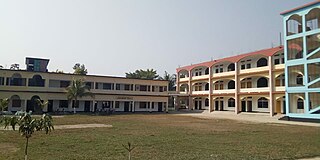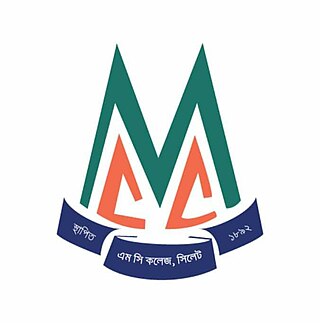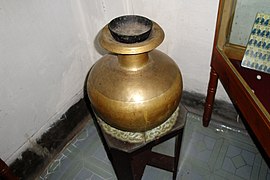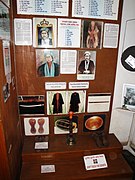
The music of Bangladesh spans a wide variety of styles. Bangladesh claims some of the most renowned singers, composers and producers in Asia. Music has served the purpose of documenting the lives of the people and was widely patronized by the rulers. It comprises a long tradition of religious and regular song-writing over a period of almost a millennium.

Dewan Hason Raja Chowdhury, or simply known as Hason Raja, Bengali: হাসন রাজা; 21 December 1854 – 6 December 1922), was a Bengali mystic poet and songwriter from Sylhet, Bengal Presidency. His unique style of music made him one of the most prominent figures in Bengali folk culture.

Sunamganj is a district located in north-eastern Bangladesh in the Sylhet Division.
Ruhul Amin is a Bangladeshi-born British film director.

Sunamganj Sadar is an upazila of Sunamganj District in the Division of Sylhet, Bangladesh.

Bishwanath is an upazila of Sylhet District in the Division of Sylhet, Bangladesh.

Murari Chand College was the first college in the Sylhet Division. It was established in 1892, making it the seventh oldest college in Bangladesh. Since then it has played an important role in the educational, cultural, and political spheres of Greater Sylhet.
Dewan Mohammad Azraf was a Bengali philosopher, teacher, author, politician, journalist and activist. In 1993, he was honoured as a National Professor in Bangladesh. He was also a supporter of the Bengali Language Movement. For his support of the movement, he was dismissed from the post of the principal of Sunamganj College in 1954, the same year he was promoted to the post. His support was particularly influential when he edited the Nao Belal in 1948. He was actively involved with Kaikobad Sahitya Majlish (1972–99).

Osmani Museum is a museum in Kotwali Thana of Sylhet, Bangladesh. The ancestors' home of Bangabir General Muhammad Ataul Gani Osmani, the Commander-in-Chief of Bangladesh Forces has been transformed into today's famous "Osmani Museum". It is situated at the heart of the Sylhet City Corporation area in renowned Sylhet Division of Bangladesh. It is about 12 km from the Sylhet Osmani International Airport and 3 km from the Sylhet Railway Station. Maintained and organised by the Bangladesh National Museum, this museum has been established to pay rich tribute to the great hero of Bangladesh for his outstanding accomplishments. This will surely act as a stimulus to the future generations. The foundation stone was laid on 16 February 1985 and it was inaugurated on 4 March 1987 by the then president of Bangladesh H M Ershad.
Kendriya Muslim Sahitya Sangsad is a literary organisation located in Sylhet, Bangladesh. It is the one of the oldest organisations of its kind in the Indian sub-continent and the oldest in Bangladesh. It was founded on 16 September 1936 by Muhammad Nurul Haque. It has the largest non-government collection of books, magazines, inscriptions etc. Some of them date back to the 13th century AD.
The Sylheti or Sylhetis are an Indo-Aryan ethnocultural group that are associated with the Sylhet region. There are strong diasporic communities in Barak Valley of Assam, India, North Tripura, as well as in rest of Bangladesh and northeast India. They speak Sylheti, an Eastern Indo-Aryan language that is considered "a distinct language by many and a dialect of Bengali by some others".
Muhammad Mansuruddin was a Bengali author, literary critic, essayist, lexicographer and biographer from Bangladesh. He was an authority on folklore and was famous for a huge collection of age-old folk songs, mostly anthologised in thirteen volumes under the title Haramoni. In recognition of his lifelong contribution to folklore collection and research, the Rabindra Bharati University awarded him D.Litt. degree in 1987.
Chowdhury is a title of honour, usually hereditary, originating from the Indian subcontinent. It is an adaption from Sanskrit. During the Mughal rule, it was a title awarded to eminent people, while during British rule, the term was associated with zamindars and social leaders. The common female equivalent was Chowdhurani. Many landlords under the Permanent Settlement carried this surname. Land reforms after the partition of India abolished the permanent settlement. In modern times, the term is a common South Asian surname for both males and females.
Sylhet Government Alia Madrasa is located in Chawhatta, Sylhet, Bangladesh. Founded in 1913, the madrasa currently has more than 650 students and 18 staff. The institution is located on the opposite side of Sylhet Government Women's College. It consists of 3 buildings, a dorm, a playground and 11,000-book-filled library.
Dewan Taimur Raja Chowdhury was a Bangladeshi politician, landowner and poet. He was the former member of parliament from Sylhet-7 as a Bangladesh Nationalist Party politician.

Shāh Muḥammad Ibrāhīm ʿAlī was a Bengali Islamic scholar, poet and activist of the Khilafat Movement. He wrote poetry in the Bengali, Urdu and Persian languages under the pen name of Tashna. His magnum opus Agnikuṇḍa is a compilation of his writings during his imprisonment.

















